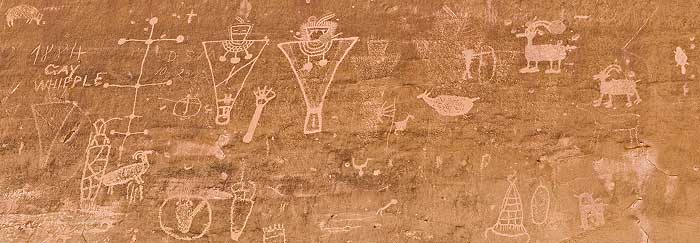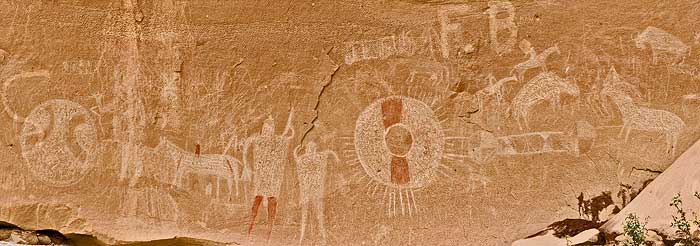The sandstone cliffs of Sego Canyon are an outdoor art gallery and a holy place. Native Americans painted and chipped their religious visions, clan symbols, and records of events onto the cliffs. There are three distinct styles present which represent three separate cultures and time periods. These cultures are known to have been in the area during the past several thousand years.
This impressive site is on the National Register of Historic Places. It undergoing long term conservation and preservation treatment. The Antiquitites Act of 1906 and the Archaeological Resources Protection Act provides for serious penalties to vandals. Sadly a lot of vandalism has occured at this site as you will see in the pictures. Like any ancient site the rocks and petroglyphs should not be touched. The oils in our skin causes the delicate paints and rock surface to deteriorate. There are many recent signatures that have been carved into the walls. Why did others sign their names at this valuable site? One can only speculate. When evey you visit a site like this, please protect it for future generations.
Here are the three distinct petroglyph styles:
Some of the most spectacular examples of rock art in the Southwest are attributed to Archaic people. Archaic people were nomads, hunting large and small game animals, collecting and processing wild plants. They did not build permanent habitation structures, but lived in caves and in small brush shelters built in the open. They occupied this area from approximately 8,000 years ago until the introduction of corn agriculture about 2,000 years ago.
This rock art, the Barrier Canyon Style, usually consists of larger than life size anthropomorphic (manlike) forms. The identifying characteristic of these figures is hollowed eyes or missing eyes, the frequent absence of arms and legs, and the anthropomorphs with bug-eyes, antennae, earrings, snakes in hand, and leg-less torsos. The "ghost-like" images, may represent shamanistic art associated with ritual activities of the Archaic people.
This picture is a mosaic of seven pictures. The original size is 11651 pixles by 3540 pixels and is avilable upon request, but because of its size it is not placed on ScienceViews.
The Fremont Culture thrived from about A.D. 600 to A.D.1250, and was contemporary with the Anasazi Culture of the Four Corners area. It is distinguished by its remarkable rock art. Like the Anasazi, the Fremont planted corn and lived in pithouses and surface stone structures. They constructed a distinctive basketry and made pottery. They had a complex social structure, as is illustrated in their rock art, and were highly adaptive to the extremes of their environment. At the top of the panel are the oldest figures. These are the line of large, red-painted figures with the rectangular-bodies and small-heads, which are similar to the Anasazi Basket maker style. Superimposed on the older, painted figures is a line of carved (pecked) human figures. Typically, these have trapezoids for the head and body. The most recent Freemont period is also represented by superimposed carvings. They are deeply groved outlines of two life-sized human figures with collars and waistbands, and the associated mountain sheep and abstract elements. This last group is representative of the Classic Fremont Style.
The Historic Ute rock art is identified and dated by the horse and rider figures. Horses were introduced to North America by the Spanish in the sixteenth century. Other figures, or elements, painted in red and white on the panel include a white bison, a human figure with leggings, several large human figures, and large circles believed to be shields. The Ute people practiced a hunting and gathering lifeway. They used the bow and arrow, and made baskets and brownware pottery, and lived in brush wikiups and tipis. The No-tah (Ute people) lived freely throughout western Colorado and eastern Utah until about 1880, when they were forced onto reservations.


